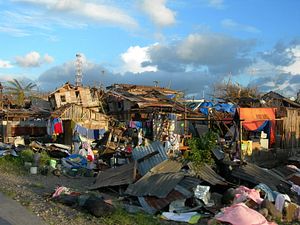Asia’s “strong man” economy of the Philippines is considered tough enough to weather the effects of Typhoon Haiyan. Yet even after the deadliest typhoon in the nation’s recorded history, analysts have warned of potentially worse storms ahead.
After making landfall on November 8, Haiyan (known as Yolanda in the Philippines) flattened dozens of towns in the central Philippines, killing more than 5,200 people, mainly in Eastern Visayas, and injuring 25,000. The official death toll is likely to rise since 1,600 people remain missing, according to government estimates.
While Haiyan has clearly exacted a terrible human toll, the economic damages from the super typhoon have been estimated at around $230 million, well below the $900 million toll of last year’s Typhoon Bopha, which struck southern areas and killed more than 1,900 people. In 2011, Typhoon Nesat inflicted around $350 million in damages after hitting the manufacturing hub of Luzon, the nation’s most populated island.
In contrast, the islands hit hardest by Haiyan produce less valuable crops such as coconut, rice and sugarcane. According to ANZ research, the Eastern Visayas region accounted for just 2.2 percent of gross domestic product (GDP) in 2012 and was the nation’s only region to actually contract in the past year.
“In the past three years, only the service sector of the region has been expanding while agriculture and industry have remained weak,” ANZ economist Eugenia Fabon Victorino said in a November 26 research report.
The economist said the Philippines’ economic fundamentals remained intact, despite some disruption to agricultural production in the fourth quarter.
ANZ downgraded its 2013 GDP growth forecast for the Philippines to 6.8 percent from 7.1 percent, due to reduced farm output, as well as predicting a higher inflation rate of 3 percent this year due to the supply-side impact on food prices.
Nevertheless, private donations from other parts of the country along with remittances from overseas Filipinos are expected to lessen Haiyan’s impact, with “anecdotal evidence” of increased remittances from Singapore and the Middle East following the tragedy. Remittances account for an estimated 10 percent of GDP, with more money traditionally returned home for year-end holidays, according to ING.
ANZ said it had actually increased its 2014 GDP forecast to 6.9 percent, up from 6.5 percent, due to reconstruction efforts, which are expected to account for 4 percent of GDP. A surge in international aid is also set to support the Philippines’ balance of payments in 2014, along with liquidity efforts by the central bank.
No longer the “sick man of Asia,” the Philippines posted GDP growth of 7.6 percent in the first half of 2013, helped by growth in the manufacturing sector. According to the Manila Times, third-quarter GDP is expected to top 7 percent, in line with the government’s 2013 forecast of growth between 6 and 7 percent.
After welcoming more than 3 million foreign visitors during the first eight months of 2013, the prospects for further growth in the tourism and real estate sectors of the Visayas remain strong despite the disaster, according to consultant Bill Barnett.
The managing director of C9 Hotelworks told the Manila Times that the Visayas remained the “perfect place” for further expansion, despite a recent 7.2 magnitude earthquake and the impact of Haiyan.
“One thing we know is that the reaction time for these kind of [calamities] is getting much quicker,” Barnett said, indicating that the recovery might be fast-tracked from the usual three to six months due to the region’s importance.
Worse to Come?
Yet while the Philippines economy is seen weathering the latest typhoon – the archipelago averages around 20 a year – analysts have raised the prospect of even more extreme weather events ahead.
According to a report by insurer Munich Re, weather-related losses and damages have risen from an annual average of $50 billion in the 1980s to near $200 billion over the past decade, with low and middle-income countries particularly exposed.
“Typhoon Haiyan, the most powerful typhoon ever to hit the Philippines, has brought into sharp focus how climate change is intensifying the severity of extreme weather events, which hurts the poor the most,” World Bank president Jim Yong Kim said in a statement.
The Asian Development Bank (ADB) has estimated that the island nations of the Pacific, including Papua New Guinea and Timor-Leste, could suffer economic losses exceeding 10 percent of GDP by 2100 due to the forecast impact of climate change on agriculture and tourism.
Both the ADB and the World Bank have urged increased investment in “disaster-resilient development” to save lives and livelihoods. For now though, the region will be holding its breath that the super typhoon did not exact an even bigger toll.

































